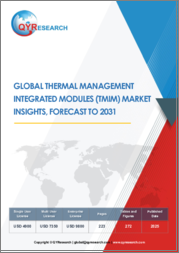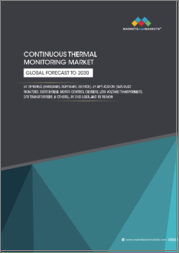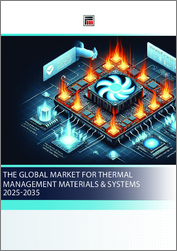
|
시장보고서
상품코드
1748779
연속 열 모니터링 시장 : 세계 산업 규모, 점유율, 동향, 기회, 예측, 컴포넌트별, 감시 유형별, 최종 용도 산업별, 지역별, 경쟁별(2020-2030년)Continuous Thermal Monitoring Market - Global Industry Size, Share, Trends, Opportunity, and Forecast, Segmented By Component, By Monitoring Type, By End-Use Industry, By Region & Competition, 2020-2030F |
||||||
세계의 연속 열 모니터링 시장 규모는 2024년에 10억 1,000만 달러, 2030년에는 14억 5,000만 달러에 달하며, CAGR 6.09%로 성장할 것으로 예측됩니다.
이러한 성장의 원동력은 발전, 제조, 헬스케어, 데이터센터 등의 산업에서 실시간 온도 모니터링 및 예지보전에 대한 수요 증가에 기인합니다. 상시 열 모니터링 시스템은 정확하고 비침습적인 온도 데이터를 제공하고 과열된 부품을 조기에 감지하여 운영의 안전성을 높이고 가동 중단 시간을 최소화합니다. 자동화 및 스마트 인프라에 초점을 맞춘 인더스트리 4.0의 부상으로 인해 채택이 더욱 가속화되고 있습니다. 에너지 분야에서는 열 모니터링이 변압기 및 회로차단기와 같은 장비를 보호하고, 데이터센터에서는 서버의 최적의 성능을 보장합니다. 또한 헬스케어 산업에서는 백신 보관 및 환자 장비 모니터링과 같은 용도로 이러한 기술을 활용하고 있으며, 다양한 분야에서 시장의 유용성이 확대되고 있습니다.
| 시장 개요 | |
|---|---|
| 예측 기간 | 2026-2030 |
| 시장 규모 : 2024년 | 10억 1,000만 달러 |
| 시장 규모 : 2030년 | 14억 5,000만 달러 |
| CAGR : 2025-2030년 | 6.09% |
| 급성장 부문 | 소프트웨어 |
| 최대 시장 | 북미 |
시장 성장 촉진요인
비접촉식 열 모니터링 솔루션 채택 증가
주요 시장 이슈
높은 초기 투자 및 설치 비용
주요 시장 동향
IoT 기반 열 모니터링 시스템 도입 증가
목차
제1장 개요
제2장 조사 방법
제3장 개요
제4장 고객의 소리
제5장 세계의 연속 열 모니터링 시장 전망
- 시장 규모·예측
- 금액별
- 시장 점유율·예측
- 컴포넌트별(하드웨어, 소프트웨어, 서비스)
- 모니터링 유형별(접촉형 모니터링, 비접촉형 모니터링)
- 최종 용도 산업별(제조·산업, 에너지·유틸리티, 데이터센터, 헬스케어, 기타)
- 지역별(북미, 유럽, 남미, 중동 및 아프리카, 아시아태평양)
- 기업별(2024)
- 시장 맵
제6장 북미의 연속 열 모니터링 시장 전망
- 시장 규모·예측
- 시장 점유율·예측
- 북미 : 국가별 분석
- 미국
- 캐나다
- 멕시코
제7장 유럽의 연속 열 모니터링 시장 전망
- 시장 규모·예측
- 시장 점유율·예측
- 유럽 : 국가별 분석
- 독일
- 프랑스
- 영국
- 이탈리아
- 스페인
제8장 아시아태평양의 연속 열 모니터링 시장 전망
- 시장 규모·예측
- 시장 점유율·예측
- 아시아태평양 : 국가별 분석
- 중국
- 인도
- 일본
- 한국
- 호주
제9장 중동 및 아프리카의 연속 열 모니터링 시장 전망
- 시장 규모·예측
- 시장 점유율·예측
- 중동 및 아프리카 : 국가별 분석
- 사우디아라비아
- 아랍에미리트
- 남아프리카공화국
제10장 남미의 연속 열 모니터링 시장 전망
- 시장 규모·예측
- 시장 점유율·예측
- 남미 : 국가별 분석
- 브라질
- 콜롬비아
- 아르헨티나
제11장 시장 역학
- 촉진요인
- 과제
제12장 시장 동향과 발전
- 합병과 인수
- 제품 출시
- 최근 동향
제13장 기업 개요
- FLIR Systems, Inc.
- Honeywell International Inc.
- Siemens AG
- General Electric Company
- Schneider Electric SE
- ABB Ltd
- Dantec Dynamics A/S
- Advanced Energy Industries
- OMEGA Engineering, Inc.
- Raytek(part of Fluke Corporation)
제14장 전략적 제안
제15장 조사회사 소개·면책사항
KSA 25.06.24The Global Continuous Thermal Monitoring Market was valued at USD 1.01 Billion in 2024 and is projected to reach USD 1.45 Billion by 2030, growing at a CAGR of 6.09%. This growth is driven by the escalating demand for real-time temperature surveillance and predictive maintenance across industries such as power generation, manufacturing, healthcare, and data centers. Continuous thermal monitoring systems deliver precise, non-intrusive temperature data that enables early detection of overheating components, thus enhancing operational safety and minimizing downtime. The rise of Industry 4.0, with its focus on automation and smart infrastructure, is further accelerating adoption. In the energy sector, thermal monitoring helps safeguard equipment like transformers and circuit breakers, while in data centers, it ensures optimal server performance. Additionally, the healthcare industry is leveraging these technologies for applications such as vaccine storage and patient equipment monitoring, expanding the market's utility across diverse sectors.
| Market Overview | |
|---|---|
| Forecast Period | 2026-2030 |
| Market Size 2024 | USD 1.01 Billion |
| Market Size 2030 | USD 1.45 Billion |
| CAGR 2025-2030 | 6.09% |
| Fastest Growing Segment | Software |
| Largest Market | North America |
Key Market Drivers
Increasing Adoption of Non-Contact Thermal Monitoring Solutions
The shift from traditional contact-based methods to non-contact thermal monitoring technologies is a significant driver of market expansion. Infrared sensors and thermal imaging cameras now dominate industrial, healthcare, and electronics applications, offering safer, faster, and more accurate temperature readings without physical contact. These systems are particularly useful in inaccessible or hazardous environments, aligning with the increasing emphasis on automation and safety. Since 2021, industrial adoption of thermal cameras has grown at an annual rate of 8-10%, with smart factories and pharmaceutical facilities leading implementation. Airports and transportation hubs have also institutionalized the use of thermal scanners. A 20% drop in the cost of non-contact IR sensors over the past five years has further supported market penetration, enhancing scalability and affordability across various industries.
Key Market Challenges
High Initial Investment and Installation Costs
Despite their long-term benefits, continuous thermal monitoring systems require a substantial initial investment, which includes the cost of sensors, thermal cameras, software, and integration infrastructure. For SMEs and businesses in developing regions, these upfront costs can be prohibitive. Retrofitting existing legacy equipment adds further expense, particularly when customization is required for industry-specific conditions such as hazardous zones or precision monitoring. The financial burden is compounded by the need for skilled technicians for system installation and training. Although these systems reduce downtime and support predictive maintenance, decision-makers often struggle to justify the capital outlay, which continues to hinder broader adoption across cost-sensitive markets.
Key Market Trends
Rising Adoption of IoT-Enabled Thermal Monitoring Systems
The integration of IoT technology into thermal monitoring systems is revolutionizing asset management. IoT-enabled sensors and cameras connect to cloud platforms, allowing for centralized, real-time data analysis across multiple facilities. This connectivity supports condition-based maintenance and enhances visibility into asset performance. Utilities, data centers, and industrial operations are using these tools to prevent failures and optimize efficiency. The modular nature of IoT-based systems allows for easy scalability, making them accessible to enterprises of all sizes. Mobile accessibility and real-time alerts improve responsiveness, while advancements in IoT security protocols ensure data protection. This transition from manual to automated, connected thermal monitoring is a defining trend in the market's evolution.
Key Market Players
- FLIR Systems, Inc.
- Honeywell International Inc.
- Siemens AG
- General Electric Company
- Schneider Electric SE
- ABB Ltd
- Dantec Dynamics A/S
- Advanced Energy Industries
- OMEGA Engineering, Inc.
- Raytek (part of Fluke Corporation)
Report Scope:
In this report, the Global Continuous Thermal Monitoring Market has been segmented into the following categories, in addition to the industry trends which have also been detailed below:
Continuous Thermal Monitoring Market, By Component:
- Hardware
- Software
- Services
Continuous Thermal Monitoring Market, By Monitoring Type:
- Contact-Based Monitoring
- Non-Contact Monitoring
Continuous Thermal Monitoring Market, By End-Use Industry:
- Manufacturing & Industrial
- Energy & Utilities
- Data Centers
- Healthcare
- Others
Continuous Thermal Monitoring Market, By Region:
- North America
- United States
- Canada
- Mexico
- Europe
- Germany
- France
- United Kingdom
- Italy
- Spain
- South America
- Brazil
- Argentina
- Colombia
- Asia-Pacific
- China
- India
- Japan
- South Korea
- Australia
- Middle East & Africa
- Saudi Arabia
- UAE
- South Africa
Competitive Landscape
Company Profiles: Detailed analysis of the major companies present in the Global Continuous Thermal Monitoring Market.
Available Customizations:
Global Continuous Thermal Monitoring Market report with the given market data, TechSci Research offers customizations according to a company's specific needs. The following customization options are available for the report:
Company Information
- Detailed analysis and profiling of additional market players (up to five).
Table of Contents
1. Product Overview
- 1.1. Market Definition
- 1.2. Scope of the Market
- 1.2.1. Markets Covered
- 1.2.2. Years Considered for Study
- 1.2.3. Key Market Segmentations
2. Research Methodology
- 2.1. Objective of the Study
- 2.2. Baseline Methodology
- 2.3. Key Industry Partners
- 2.4. Major Association and Secondary Sources
- 2.5. Forecasting Methodology
- 2.6. Data Triangulation & Validation
- 2.7. Assumptions and Limitations
3. Executive Summary
- 3.1. Overview of the Market
- 3.2. Overview of Key Market Segmentations
- 3.3. Overview of Key Market Players
- 3.4. Overview of Key Regions/Countries
- 3.5. Overview of Market Drivers, Challenges, and Trends
4. Voice of Customer
5. Global Continuous Thermal Monitoring Market Outlook
- 5.1. Market Size & Forecast
- 5.1.1. By Value
- 5.2. Market Share & Forecast
- 5.2.1. By Component (Hardware, Software, Services)
- 5.2.2. By Monitoring Type (Contact-Based Monitoring, Non-Contact Monitoring)
- 5.2.3. By End-Use Industry (Manufacturing & Industrial, Energy & Utilities, Data Centers, Healthcare, Others)
- 5.2.4. By Region (North America, Europe, South America, Middle East & Africa, Asia Pacific)
- 5.3. By Company (2024)
- 5.4. Market Map
6. North America Continuous Thermal Monitoring Market Outlook
- 6.1. Market Size & Forecast
- 6.1.1. By Value
- 6.2. Market Share & Forecast
- 6.2.1. By Component
- 6.2.2. By Monitoring Type
- 6.2.3. By End-Use Industry
- 6.2.4. By Country
- 6.3. North America: Country Analysis
- 6.3.1. United States Continuous Thermal Monitoring Market Outlook
- 6.3.1.1. Market Size & Forecast
- 6.3.1.1.1. By Value
- 6.3.1.2. Market Share & Forecast
- 6.3.1.2.1. By Component
- 6.3.1.2.2. By Monitoring Type
- 6.3.1.2.3. By End-Use Industry
- 6.3.1.1. Market Size & Forecast
- 6.3.2. Canada Continuous Thermal Monitoring Market Outlook
- 6.3.2.1. Market Size & Forecast
- 6.3.2.1.1. By Value
- 6.3.2.2. Market Share & Forecast
- 6.3.2.2.1. By Component
- 6.3.2.2.2. By Monitoring Type
- 6.3.2.2.3. By End-Use Industry
- 6.3.2.1. Market Size & Forecast
- 6.3.3. Mexico Continuous Thermal Monitoring Market Outlook
- 6.3.3.1. Market Size & Forecast
- 6.3.3.1.1. By Value
- 6.3.3.2. Market Share & Forecast
- 6.3.3.2.1. By Component
- 6.3.3.2.2. By Monitoring Type
- 6.3.3.2.3. By End-Use Industry
- 6.3.3.1. Market Size & Forecast
- 6.3.1. United States Continuous Thermal Monitoring Market Outlook
7. Europe Continuous Thermal Monitoring Market Outlook
- 7.1. Market Size & Forecast
- 7.1.1. By Value
- 7.2. Market Share & Forecast
- 7.2.1. By Component
- 7.2.2. By Monitoring Type
- 7.2.3. By End-Use Industry
- 7.2.4. By Country
- 7.3. Europe: Country Analysis
- 7.3.1. Germany Continuous Thermal Monitoring Market Outlook
- 7.3.1.1. Market Size & Forecast
- 7.3.1.1.1. By Value
- 7.3.1.2. Market Share & Forecast
- 7.3.1.2.1. By Component
- 7.3.1.2.2. By Monitoring Type
- 7.3.1.2.3. By End-Use Industry
- 7.3.1.1. Market Size & Forecast
- 7.3.2. France Continuous Thermal Monitoring Market Outlook
- 7.3.2.1. Market Size & Forecast
- 7.3.2.1.1. By Value
- 7.3.2.2. Market Share & Forecast
- 7.3.2.2.1. By Component
- 7.3.2.2.2. By Monitoring Type
- 7.3.2.2.3. By End-Use Industry
- 7.3.2.1. Market Size & Forecast
- 7.3.3. United Kingdom Continuous Thermal Monitoring Market Outlook
- 7.3.3.1. Market Size & Forecast
- 7.3.3.1.1. By Value
- 7.3.3.2. Market Share & Forecast
- 7.3.3.2.1. By Component
- 7.3.3.2.2. By Monitoring Type
- 7.3.3.2.3. By End-Use Industry
- 7.3.3.1. Market Size & Forecast
- 7.3.4. Italy Continuous Thermal Monitoring Market Outlook
- 7.3.4.1. Market Size & Forecast
- 7.3.4.1.1. By Value
- 7.3.4.2. Market Share & Forecast
- 7.3.4.2.1. By Component
- 7.3.4.2.2. By Monitoring Type
- 7.3.4.2.3. By End-Use Industry
- 7.3.4.1. Market Size & Forecast
- 7.3.5. Spain Continuous Thermal Monitoring Market Outlook
- 7.3.5.1. Market Size & Forecast
- 7.3.5.1.1. By Value
- 7.3.5.2. Market Share & Forecast
- 7.3.5.2.1. By Component
- 7.3.5.2.2. By Monitoring Type
- 7.3.5.2.3. By End-Use Industry
- 7.3.5.1. Market Size & Forecast
- 7.3.1. Germany Continuous Thermal Monitoring Market Outlook
8. Asia Pacific Continuous Thermal Monitoring Market Outlook
- 8.1. Market Size & Forecast
- 8.1.1. By Value
- 8.2. Market Share & Forecast
- 8.2.1. By Component
- 8.2.2. By Monitoring Type
- 8.2.3. By End-Use Industry
- 8.2.4. By Country
- 8.3. Asia Pacific: Country Analysis
- 8.3.1. China Continuous Thermal Monitoring Market Outlook
- 8.3.1.1. Market Size & Forecast
- 8.3.1.1.1. By Value
- 8.3.1.2. Market Share & Forecast
- 8.3.1.2.1. By Component
- 8.3.1.2.2. By Monitoring Type
- 8.3.1.2.3. By End-Use Industry
- 8.3.1.1. Market Size & Forecast
- 8.3.2. India Continuous Thermal Monitoring Market Outlook
- 8.3.2.1. Market Size & Forecast
- 8.3.2.1.1. By Value
- 8.3.2.2. Market Share & Forecast
- 8.3.2.2.1. By Component
- 8.3.2.2.2. By Monitoring Type
- 8.3.2.2.3. By End-Use Industry
- 8.3.2.1. Market Size & Forecast
- 8.3.3. Japan Continuous Thermal Monitoring Market Outlook
- 8.3.3.1. Market Size & Forecast
- 8.3.3.1.1. By Value
- 8.3.3.2. Market Share & Forecast
- 8.3.3.2.1. By Component
- 8.3.3.2.2. By Monitoring Type
- 8.3.3.2.3. By End-Use Industry
- 8.3.3.1. Market Size & Forecast
- 8.3.4. South Korea Continuous Thermal Monitoring Market Outlook
- 8.3.4.1. Market Size & Forecast
- 8.3.4.1.1. By Value
- 8.3.4.2. Market Share & Forecast
- 8.3.4.2.1. By Component
- 8.3.4.2.2. By Monitoring Type
- 8.3.4.2.3. By End-Use Industry
- 8.3.4.1. Market Size & Forecast
- 8.3.5. Australia Continuous Thermal Monitoring Market Outlook
- 8.3.5.1. Market Size & Forecast
- 8.3.5.1.1. By Value
- 8.3.5.2. Market Share & Forecast
- 8.3.5.2.1. By Component
- 8.3.5.2.2. By Monitoring Type
- 8.3.5.2.3. By End-Use Industry
- 8.3.5.1. Market Size & Forecast
- 8.3.1. China Continuous Thermal Monitoring Market Outlook
9. Middle East & Africa Continuous Thermal Monitoring Market Outlook
- 9.1. Market Size & Forecast
- 9.1.1. By Value
- 9.2. Market Share & Forecast
- 9.2.1. By Component
- 9.2.2. By Monitoring Type
- 9.2.3. By End-Use Industry
- 9.2.4. By Country
- 9.3. Middle East & Africa: Country Analysis
- 9.3.1. Saudi Arabia Continuous Thermal Monitoring Market Outlook
- 9.3.1.1. Market Size & Forecast
- 9.3.1.1.1. By Value
- 9.3.1.2. Market Share & Forecast
- 9.3.1.2.1. By Component
- 9.3.1.2.2. By Monitoring Type
- 9.3.1.2.3. By End-Use Industry
- 9.3.1.1. Market Size & Forecast
- 9.3.2. UAE Continuous Thermal Monitoring Market Outlook
- 9.3.2.1. Market Size & Forecast
- 9.3.2.1.1. By Value
- 9.3.2.2. Market Share & Forecast
- 9.3.2.2.1. By Component
- 9.3.2.2.2. By Monitoring Type
- 9.3.2.2.3. By End-Use Industry
- 9.3.2.1. Market Size & Forecast
- 9.3.3. South Africa Continuous Thermal Monitoring Market Outlook
- 9.3.3.1. Market Size & Forecast
- 9.3.3.1.1. By Value
- 9.3.3.2. Market Share & Forecast
- 9.3.3.2.1. By Component
- 9.3.3.2.2. By Monitoring Type
- 9.3.3.2.3. By End-Use Industry
- 9.3.3.1. Market Size & Forecast
- 9.3.1. Saudi Arabia Continuous Thermal Monitoring Market Outlook
10. South America Continuous Thermal Monitoring Market Outlook
- 10.1. Market Size & Forecast
- 10.1.1. By Value
- 10.2. Market Share & Forecast
- 10.2.1. By Component
- 10.2.2. By Monitoring Type
- 10.2.3. By End-Use Industry
- 10.2.4. By Country
- 10.3. South America: Country Analysis
- 10.3.1. Brazil Continuous Thermal Monitoring Market Outlook
- 10.3.1.1. Market Size & Forecast
- 10.3.1.1.1. By Value
- 10.3.1.2. Market Share & Forecast
- 10.3.1.2.1. By Component
- 10.3.1.2.2. By Monitoring Type
- 10.3.1.2.3. By End-Use Industry
- 10.3.1.1. Market Size & Forecast
- 10.3.2. Colombia Continuous Thermal Monitoring Market Outlook
- 10.3.2.1. Market Size & Forecast
- 10.3.2.1.1. By Value
- 10.3.2.2. Market Share & Forecast
- 10.3.2.2.1. By Component
- 10.3.2.2.2. By Monitoring Type
- 10.3.2.2.3. By End-Use Industry
- 10.3.2.1. Market Size & Forecast
- 10.3.3. Argentina Continuous Thermal Monitoring Market Outlook
- 10.3.3.1. Market Size & Forecast
- 10.3.3.1.1. By Value
- 10.3.3.2. Market Share & Forecast
- 10.3.3.2.1. By Component
- 10.3.3.2.2. By Monitoring Type
- 10.3.3.2.3. By End-Use Industry
- 10.3.3.1. Market Size & Forecast
- 10.3.1. Brazil Continuous Thermal Monitoring Market Outlook
11. Market Dynamics
- 11.1. Drivers
- 11.2. Challenges
12. Market Trends and Developments
- 12.1. Merger & Acquisition (If Any)
- 12.2. Product Launches (If Any)
- 12.3. Recent Developments
13. Company Profiles
- 13.1. FLIR Systems, Inc.
- 13.1.1. Business Overview
- 13.1.2. Key Revenue and Financials
- 13.1.3. Recent Developments
- 13.1.4. Key Personnel
- 13.1.5. Key Product/Services Offered
- 13.2. Honeywell International Inc.
- 13.3. Siemens AG
- 13.4. General Electric Company
- 13.5. Schneider Electric SE
- 13.6. ABB Ltd
- 13.7. Dantec Dynamics A/S
- 13.8. Advanced Energy Industries
- 13.9. OMEGA Engineering, Inc.
- 13.10. Raytek (part of Fluke Corporation)



















